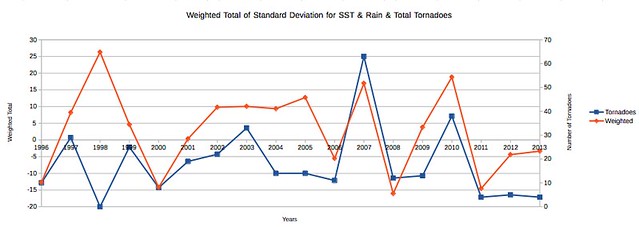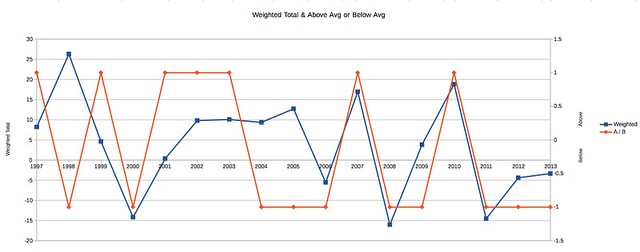There was a correlation between the weighted totals of the standard deviations from the mean of the anomalies of GoA SST, GoM SST, Previous Precipitation, ENSO SST when compared against the total number of tornadoes and the number of tornado days for that year for the data from 1996 to 2014.
Sixty-three percent of the time when the weighted total was above zero, that season was an above average year for tornado numbers. One-hundred percent of the time when the weighted total was below zero it was a below average year for tornado numbers
Eighty-one percent of the time when the weighted total was above zero it was an average or above average year for tornado days. Seventy-one percent of the time when the weighted total was below zero it was a below average year for tornado days.
One year, 2004, there was an above average weighted total and there was an average number of spring tornado days.
Overall, the weighted total – positive or negative – matched the number of tornado days – above average of below average – 78 percent of the time. The same comparison made against the total number of tornadoes also matched 78 percent of the time.
Eighty percent of the above average tornado days years had the first tornado day on or after April 15.
In 1996, there was a below average number of tornadoes (10) on an above average number of tornado days (9).
In 1998, there were no spring tornadoes recorded. This could be due to a strong El Nino which registered anomalies at four standard deviations above the mean. But it could also be due to cooler than normal temperatures in the GoM which was two standard deviations below the mean.
In 1999, there was a large spread in standard deviations from the mean for temperatures between GoA (-4) and GoM (+4) and the previous fall / winter precipitation was also four standard deviations above the mean, may have led to an above average tornado season despite a ENSO registering at three standard deviations below the mean (strong La Nina).
In 2004, every category measured (GoA, GoM, Previous Precipitation, ENSO) was within one standard deviation above the mean. There was an average number of tornado days and fourteen total spring tornadoes – only one below average. The weighted total was 9.35. The first tornado was on April, 19.
In 2007, there were 63 tornadoes during nine tornado days. The weighted total was the third-most positive recorded.
During the 2011, 2012 and 2013 season the weighted total was negative and there was a prolific drought (that is still ongoing at the time of this writing). Each year was greater than one standard deviation below the mean for previous precipitation and ENSO, this likely trumped any opportunity for an active severe weather season and was apparent when looking at tornado days and total spring tornadoes as both categories fell one or two standard deviations below the mean.



